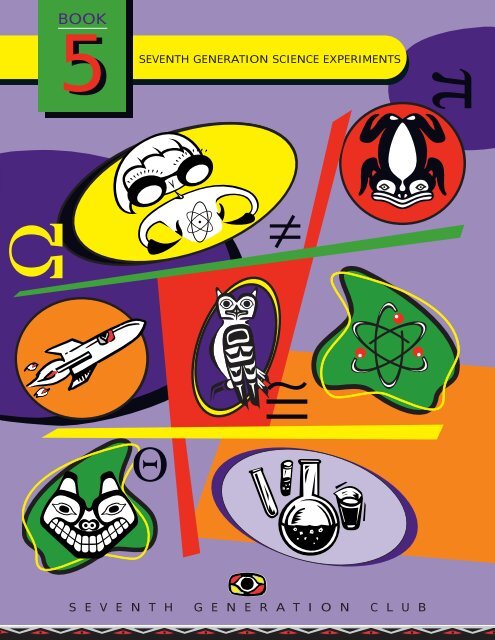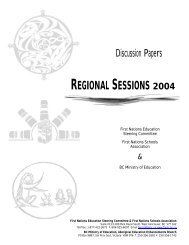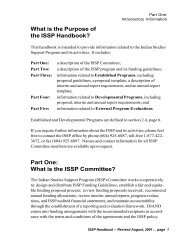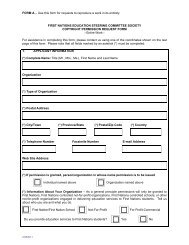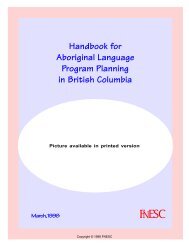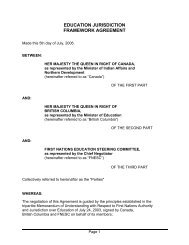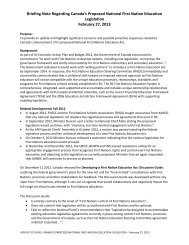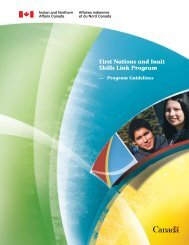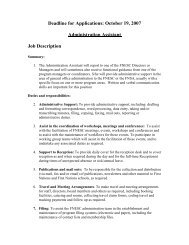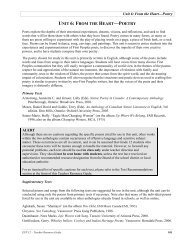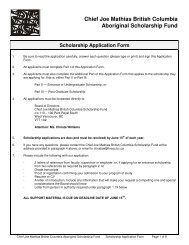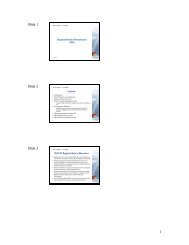seventh generation science experiments - FNESC
seventh generation science experiments - FNESC
seventh generation science experiments - FNESC
Create successful ePaper yourself
Turn your PDF publications into a flip-book with our unique Google optimized e-Paper software.
Ω<br />
BOOK<br />
5<br />
SEVENTH GENERATION SCIENCE EXPERIMENTS<br />
Θ<br />
≠<br />
≅<br />
S E V E N T H G E N E R A T I O N C L U B<br />
π
The Seventh Generation Club thanks Mad Science<br />
for their contribution of the twelve <strong>experiments</strong><br />
found in the Seventh Generation Club Science<br />
Experiments Book 5.<br />
Mad Science has a mission to spark the imagination<br />
and curiosity of children everywhere by providing<br />
them with fun, interactive and educational activities<br />
that instill a clear understanding of what <strong>science</strong> is all<br />
about and how it affects the world around them.<br />
Mad Science offers a variety of programs available<br />
in British Columbia including school assemblies<br />
with engaging <strong>science</strong> shows, age appropriate<br />
school workshops, and <strong>science</strong> camps. All Mad<br />
Science programs meet British Columbia Integrated<br />
Resource Package (IRP) requirements, include preand<br />
post-activities, reliable instructions, professional<br />
lesson plans, equipment, and the programs include<br />
language arts and math extension activities.<br />
For more information on how to host a Mad Science<br />
program at your school or event, please contact:<br />
Bill and/or Jennifer Collette<br />
Mad Science<br />
PO Box 1086<br />
Parksville, BC<br />
V9P 2H1<br />
Call toll free at 1-888-954-MADS (6237), or 250-954-2091<br />
www.mad<strong>science</strong>.org/vancouverisland
Table of Contents<br />
Experiment #1: The Spinning Spool<br />
Experiment #2: Acid Attack<br />
Experiment #3: Balloon-mobile<br />
Experiment #4: Balloon Barometer<br />
Experiment #5: Construct a Compass - Option 1<br />
Experiment #6: Construct a Compass - Option 2<br />
Experiment #7: Enviroeducation<br />
Experiment #8: Flazoot Toot<br />
Experiment #9: Frosty Broth<br />
Experiment #10: Rain Gauge<br />
Experiment #11: Soda Spew<br />
Experiment #12: The Balancing Act<br />
Experiment #13: The Comeback Can<br />
The Galaxy<br />
we live in is<br />
called the<br />
Milky Way.<br />
It is shaped<br />
kind of like<br />
a) A round ball<br />
b) A pretzel<br />
c) A doughnut<br />
d) A flat spiral<br />
If you want to see the<br />
centre of the Milky Way,<br />
face south during an<br />
evening in August to<br />
October. Looking above<br />
the horizon, you will see<br />
the centre of the flat spiral<br />
that is our galaxy.<br />
Answer: A flat spiral
How many<br />
bones are in<br />
your body<br />
a) 600<br />
b) 250<br />
c) 130<br />
d) 206<br />
You were born with 250<br />
bones, but some of your<br />
bones fused together. By<br />
the time you reach your<br />
parents’ age, you will only<br />
have 200!<br />
Answer: D<br />
The Spinning Spool<br />
Have you ever seen or rode on a hovercraft? Hovercrafts, also<br />
called air-cushioned vehicles (ACV), can carry passengers, vehicles,<br />
and freight across land and water. Some hovercrafts can travel<br />
as fast as 130 kilometers per hour!<br />
What you need:<br />
Cardboard Ruler<br />
Scissors Sharpened pencil<br />
Glue Paper<br />
Balloon<br />
Styrofoam or plastic spool (like the ones used for thread)<br />
What you do:<br />
Cut a 4-inch square out of cardboard.<br />
Using a sharpened pencil, carefully poke a hole in the center of the<br />
piece of cardboard. Ensure that the hole in the cardboard is the same<br />
size as the hole in the center of the spool.<br />
Glue the spool to the cardboard so that the hole in the cardboard is in<br />
line with the hole in the center of the spool. Use a generous amount<br />
of glue, but ensure that the glue does not obstruct the hole in the<br />
center of the spool.<br />
Create a lid for the other end of the spool. Cut a circle out of paper<br />
that has the same diameter as the spool. Glue the paper cover to the<br />
top end of the spool.<br />
Poke a hole in the paper cover so that is in line with the hole in the<br />
spool. At this point, you should have a hole running through the<br />
paper, spool, and cardboard without any obstructions.<br />
Blow up a balloon and twist the end to keep the air from escaping.<br />
Stretch the mouth of the balloon over the top end of the spool.<br />
Place your hovercraft on a level table and let go of the balloon!<br />
What’s going on?<br />
The air flowing from the balloon through the hole in the center of<br />
the spool forms a layer of air between the cardboard and the<br />
table.This layer of air acts like an invisible cushion and eliminates<br />
the friction that normally exists when the cardboard rests directly<br />
on the table.This reduction in friction causes the “hovercraft”<br />
to scoot across the table!
Have you ever eaten something that made your tummy hurt? Maybe<br />
you heard your parents complain about heartburn after eating a large<br />
meal? There is a very strong acid in our stomach that helps us to digest<br />
the food that we eat. Occasionally, when we eat too much, some of that<br />
stomach acid makes its way up and out of our stomach, and into our<br />
esophagus.The esophagus is part of the tube that food travels down on<br />
the way to our stomach. Your stomach has a very strong lining so the<br />
acid doesn’t hurt it, but the esophagus does not. Stomach acid can<br />
make your esophagus feel like it is burning! Your esophagus is right in<br />
front of your heart, which is why this strange burning feeling is called<br />
heartburn.<br />
What you need:<br />
Newspaper Rolaids®, Tums®, or other antacids<br />
Spoon Lemon juice or vinegar<br />
Two small bowls<br />
What you do:<br />
Spread out some newspaper on the table where you will be working.<br />
Squirt some lemon juice or vinegar into one of the small bowls.<br />
Put two antacid tablets into the other small bowl. Use the back of the<br />
spoon to crush the tablets into powder.<br />
Spoon a small amount of antacid powder into the lemon juice or vinegar.<br />
Stir the mixture and observe, or watch, what happens. You should be<br />
able to observe the solution foaming, or producing small bubbles.<br />
When the foaming has stopped, add a little more antacid powder to<br />
the lemon juice or vinegar. Stir, and observe what happens.<br />
Continue adding small amounts of antacid powder until the lemon<br />
juice or vinegar does not bubble any more.<br />
What’s going on?<br />
Acid Attack<br />
Normally, our stomach digests the food that we eat without any<br />
problems. However, every once in a while, we get an upset stomach<br />
or a burning feeling in our chest. By taking an antacid like the ones<br />
used in this experiment,we can neutralize the acid that is bothering<br />
us, making it harmless. How do antacids work? Antacids all have<br />
one thing in common: they all contain a chemical known as a base.<br />
Bases react with acids, often producing a gas and neutralizing the<br />
acid. When you added the antacid to the lemon juice or vinegar<br />
(acids) the mixture bubbled and the amount of acid in the mixture<br />
dropped. Antacids work the same way in your stomach. Antacids<br />
reduce the level of acidity and help your stomachache go away.<br />
True or<br />
False:<br />
The largest<br />
organ in<br />
your body is<br />
your liver<br />
If you were able to stretch<br />
your skin out flat, it would<br />
cover about the same area<br />
as a pool table.<br />
Answer: False
True or<br />
False:<br />
The most<br />
powerful<br />
muscle in<br />
the human<br />
body is your<br />
jaw muscle<br />
Muscles get stronger by<br />
being used and your jaw<br />
muscle certainly gets a lot<br />
of exercise, whether it be<br />
when you chew your food<br />
or talk to your friends.<br />
Answer: True<br />
Balloon-mobile<br />
Build and test a race car that uses a balloon as it’s only energy<br />
source!<br />
What you need:<br />
2-L milk carton<br />
Scissors<br />
Large balloon<br />
2 drinking straws<br />
4 Styrofoam or plastic spools (like the ones used for thread)<br />
4 straight pins<br />
What you do:<br />
Cut off the top of a 2-L milk carton.<br />
Cut the milk carton in half, the long way.This will form the body of your<br />
car.<br />
Cut a small hole in the middle of the end of the carton.The hole should<br />
be big enough so that the end of a deflated balloon can be placed into<br />
it with ease. Note: If the hole is too big or too small, there won’t be<br />
enough air force to move the car.<br />
Make 2 holes, close to the bottom, at opposite ends of one side of the<br />
carton. Do the same thing on the other side of the carton.These holes<br />
are for the wheel axles of your car. Stick the drinking straws though<br />
these holes.<br />
Slide the spools onto the straws and use pins to secure the straws to<br />
the spools (i.e., stick the pins through the straws on either side of the<br />
spools to prevent them from sliding one way or another).<br />
Blow up the balloon (don’t tie the end) and let the air in the balloon<br />
out so that it pushes your car forward!<br />
What’s going on?<br />
The air rushing out of the balloon pushes the balloon in the opposite<br />
direction from the airflow.This is called propulsion.The racecar<br />
is propelled along the floor according to the principle stated in<br />
Newton’s Third Law of Motion:“Every action has an equal and<br />
opposite reaction.”The escaping air is the action and the movement<br />
of the car in the opposite direction is the reaction.
Balloon Barometer<br />
A barometer is an instrument used for determining the weight or pressure<br />
of the atmosphere. When scientists know the pressure in the air,<br />
they can use it to predict changes in weather. Learn how to make your<br />
own barometer and become a weather expert at home!<br />
What you need:<br />
Glass jar (e.g., pickle jar) Balloon Rubber band<br />
2 drinking straws Tape Play-dough<br />
Construction paper Ruler<br />
What you do:<br />
Cut open a balloon and stretch it over the mouth of a jar.<br />
Secure the balloon on the mouth of the jar using a rubber band.<br />
Tape 2 drinking straws together to make a really long straw.<br />
Tape one end of the long straw to the middle of the stretched balloon so<br />
that the straw is sticking out, perpendicular to the jar.<br />
Cut a small triangle out of construction paper and tape it to the end of<br />
the long straw that is pointing away from the jar.This paper triangle will<br />
act as a pointer.<br />
Support a ruler with play-dough in an upright position on a flat surface<br />
(e.g., table or counter).<br />
Arrange the glass jar in such a way that the paper triangle at the end<br />
of the straw is pointing at the ruler.<br />
Record the height on the ruler that the triangle aligns with at various<br />
times during the day.<br />
Use the table below to record the reading at the same time of the day<br />
for at least a week.<br />
Collect weather charts each day and check to see whether the<br />
changes in pressure that you record match those recorded by your<br />
local weather bureau. Compare your pressure readings with those<br />
from a real barometer.<br />
What’s going on?<br />
When the pointer on your homemade barometer is pointing at the<br />
high numbers on the ruler, it means that the air pressure is high<br />
and that it is pushing down on the balloon covering the mouth of<br />
the jar. When the air pressure is high, you generally have nice,<br />
sunny weather.When the pointer is pointing at the lower numbers<br />
on the ruler, the air pressure is low and it is not pushing down on<br />
the balloon.When the air pressure is low, you generally have rainy<br />
weather.<br />
Day Time Barometer<br />
Reading<br />
1<br />
2<br />
3<br />
4<br />
5<br />
6<br />
7<br />
True or<br />
False:<br />
The air you<br />
expel in a<br />
sneeze<br />
travels<br />
about as<br />
quickly as a<br />
hurricane<br />
force wind<br />
Hurricanes move clockwise<br />
or counter-clockwise,<br />
depending on what part of<br />
the world they are<br />
spinning around in!<br />
Answer: True
What is a<br />
“googol”?<br />
a) a large sea bird<br />
b) a mammal found only in<br />
Australia<br />
c) a number written as “1”<br />
followed by 100 zeros<br />
d) a delicious frozen<br />
dessert<br />
There is also something<br />
called a “googolplex” which<br />
is equal to a googol times a<br />
googol. Now that’s big!<br />
Answer: C<br />
Construct a Compass<br />
A magnet is the key part of a compass. A magnetic compass consists<br />
of a small, lightweight magnet balanced on a nearly frictionless<br />
pivot point.The magnet is generally called a needle. One end of the<br />
needle is marked with an “N” for north or is colored in some way to<br />
indicate that it points toward north.<br />
Option 1<br />
What you need:<br />
Shallow dish (e.g., a pie plate)<br />
Needle (or some other wire-like piece of steel such as a straightened<br />
paper clip<br />
Something small that floats (e.g., piece of cork, bottom of a Styrofoam<br />
coffee cup, piece of plastic, cap from a milk jug)<br />
Magnet<br />
Water<br />
What you do:<br />
Fill the pie plate so that there is about an inch (2.5 cm) of water in it<br />
Stroke the magnet along your needle 10-20 times. If you don’t have a<br />
magnet lying around the house, try using the magnet from a can<br />
opener. Stroke your needle from the center to the end. Test the magnetized<br />
needle by placing it near an iron or steel surface to see if there<br />
is an attractive force.<br />
Place your float in the middle of the dish of water.<br />
Center your magnetic needle on the float. It very slowly will point<br />
toward north.You have just created a compass!
Construct a Compass<br />
Cont.<br />
Option 2<br />
What you need:<br />
Needle (or some other wire-like piece of steel such as a straightened<br />
paper clip)<br />
Wide-mouthed glass jar<br />
Pencil<br />
Construction paper<br />
Scissors<br />
Thread<br />
Magnet<br />
What you do:<br />
Obtain a clean, wide-mouthed glass jar.<br />
Cut a circle/disk out of a piece of stiff paper. Make the diameter of the<br />
disk about half the diameter of the inside of your jar.<br />
Magnetize a darning needle by stroking it several times with a magnet.<br />
Stroke the needle from the center to the end.Test the magnetized<br />
needle by placing it near an iron or steel surface to see if there is an<br />
attractive force.<br />
Carefully poke the needle through the center of the paper disk and<br />
leave the needle stuck in the disk.<br />
Use thread and a pencil to suspend the needle and stiff paper apparatus<br />
you have just made inside the jar. Make certain that the apparatus<br />
does not touch the sides of the jar.<br />
Test your homemade compass by comparing the direction of your<br />
hanging needle to the direction of a needle in a real compass.<br />
What’s Going On?<br />
No matter where you stand on Earth, you can hold a compass in<br />
your hand and it will point toward the North Pole.Think of the Earth<br />
as having a huge bar magnet buried inside.For the north end of the<br />
compass to point toward the North Pole, the buried bar magnet<br />
must have its south end at the North Pole. The normal “opposites<br />
attract” rule of magnets applies in this case and causes the north<br />
end of the compass needle to point toward the south end of the<br />
buried bar magnet. So the compass points toward the North Pole.<br />
True or<br />
False:<br />
Fish can’t<br />
close their<br />
eyes<br />
Your eyelids protect your<br />
eyes from dirt and dust,<br />
and allow them to stay<br />
wet. Fish don’t need eyelids<br />
because their eyes always<br />
stay wet.<br />
Answer: True
How long<br />
does it take<br />
for sunlight<br />
to travel<br />
from the sun<br />
to the earth<br />
a) 8 seconds<br />
b) 8 hours<br />
c) 8 minutes<br />
d) 8 days<br />
The sun is approximately<br />
149,600,000 km away and<br />
light travels at an amazing<br />
299,4792,458 metres per<br />
second.<br />
Answer: C<br />
Enviroeducation<br />
Be a Pollution Preventer!<br />
Air is all around us, and it is constantly moving. As air moves, it picks<br />
up dust, smog, pollen and dirt. This is the air we breathe into our<br />
lungs. Have you ever wondered what is in the air that we breathe?<br />
As the world population grows, more people drive cars, use air conditioning,<br />
create waste, and depend on production factories that<br />
produce waste by-products. All of these factors and many others<br />
contribute to the pollution of the air around us. In this experiment,<br />
you will be able to see exactly what is in the air you are breathing!<br />
What you need:<br />
2 pieces of wax paper (10 cm x 10 cm) Petroleum jelly<br />
2 pieces of cardboard (10 cm x 10 cm) Magnifying glass<br />
Tape<br />
What you do:<br />
Tape the wax paper onto each piece of cardboard – these will serve as<br />
your dirty air collectors.<br />
With your fingers, spread petroleum jelly lightly onto the wax paper surface.<br />
Place the collectors in an area where it will be easy to retrieve them<br />
(your backyard garden, your bedroom, or your garage).<br />
Leave your collectors in place for 24 hours. Using a magnifying glass,<br />
observe your collectors carefully.<br />
Do you notice anything in the petroleum jelly? Is there a difference<br />
between some of the collectors? For example, is there a difference<br />
between what was collected from the sidewalk as compared to your<br />
bedroom?<br />
What’s going on?<br />
What can you do to help reduce the amount of pollution in the air?<br />
Walk or ride your bike instead of getting your parents to drive you<br />
somewhere. Or, if you have to drive a long distance, see if you can<br />
carpool with your friends and neighbours.Taking public transportation<br />
is also a good way to reduce harmful gas emissions. Don’t keep<br />
the air conditioning on during mild days. Save energy to cut down<br />
on emissions. The reservoirs where most of our household energy<br />
comes from produce methane, a greenhouse gas. To reduce the<br />
amount of energy you use, take shorter and cooler showers or<br />
baths. Hang dry your clothes instead of using the dryer. Turn the<br />
lights off when you leave a room, and turn the T.V off when you’re<br />
not watching it – as a matter of fact, why don’t you try turning the<br />
T.V off for a whole week.You’ll be saving a lot of energy, and you’ll<br />
find yourself with more time to read a good book, play outdoors<br />
and spend time with your friends!
Enviroeducation Cont.<br />
Be a Water Conserver!<br />
Speaking of conserving energy, have you ever considered how much<br />
water you use in a day? Think about it, you use water to wash your face,<br />
brush your teeth, take a bath or shower, flush the toilet, water your plants,<br />
sprinkle the garden, change the water in your fish bowl or aquarium,<br />
wash fruits and vegetables, wash your clothes, clean up messes, maybe<br />
you even fill your swimming or wading pool with water. Not to mention<br />
we are supposed to be drinking 6-8 glasses of the stuff per day! Phew,<br />
that’s a lot of water consumption. But did you know that there is only a<br />
limited amount of water left in the world? We are not in danger of running<br />
out any time soon, but we should be more careful with how much<br />
clean water we are using. How much water are you using?<br />
What you need:<br />
Heavy, narrow, waterproof object (like a narrow detergent bottle filled<br />
with water)<br />
Small cooking pot<br />
Measuring cup<br />
Flushing<br />
Ask an adult to lift the cover off your toilet tank. Flush the toilet, and<br />
observe how the mechanism works. Each flush uses about 20 litres of<br />
water, much more than you need on your average flush!<br />
Place a heavy object into your toilet tank without disturbing the flushing<br />
mechanism.This will displace some of the water so that a lot less is<br />
needed to fill the tank.<br />
Brushing<br />
Do you brush your teeth with the water running? If so, you may be<br />
wasting more water than you think.<br />
Put a pot in the sink the next time you brush your teeth. When you<br />
finish,turn off the tap.How much water is in the pot? Measure it with<br />
a measuring cup. Think of all the water you could be saving if you<br />
remembered to turn the tap off every time you brushed!<br />
By conserving water you’re also saving on the energy required to<br />
clean, purify and transport water into the tap in your sink!<br />
Which of<br />
these<br />
animals can<br />
live the<br />
longest<br />
without<br />
water<br />
a) rat<br />
b) water buffalo<br />
c) camel<br />
d) turtle<br />
The jaws of the rat are so<br />
powerful, they have been<br />
known to gnaw through<br />
lead pipes to get to food!<br />
Answer: A
How many<br />
times does<br />
the average<br />
person blink<br />
in one<br />
minute<br />
a) 56<br />
b) 12<br />
c) 25<br />
d) 110<br />
Your eyelids may feel<br />
heavier when you are tired,<br />
but they really aren’t.You<br />
just lose control over them<br />
when you are tired and<br />
getting ready for sleep.<br />
Answer: C<br />
Some wind instruments use a vibrating membrane (e.g., wax paper,<br />
balloon rubber) to help make sounds. These instruments are called<br />
mirlitons. The flazoot is an example of a mirlition, along with its<br />
close cousin, the kazoo.<br />
What you need:<br />
2 balloons<br />
2 rubber bands<br />
Toilet paper tube<br />
Scissors<br />
What you do:<br />
Get an adult to help you punch a hole halfway down the tube with<br />
scissors.The hole should be about 1 cm wide.<br />
Trim off the excess cardboard carefully until you have a nice neat hole.<br />
Cut the necks off the two balloons and stretch one over one end of the<br />
tube.<br />
Secure it in place with the rubber band.<br />
Repeat the process for the other side of the tube. Make sure the balloons<br />
are stretched nice and tight.<br />
Flazoot Away!<br />
Flazoot Toot<br />
Put your lips up to the hole and gently blow across it. If you don’t get<br />
a sound right away, you might want to practice with an empty soda<br />
bottle. Once you have got the sound with a bottle, then go back and<br />
try your Flazoot. When you have a steady sound, gently push on the<br />
rubber walls. What happens? Also try pushing one side at a time, or<br />
with different amounts of pressure on each side.<br />
What’s going on?<br />
The flazoot’s balloon walls vibrate as you blow air across the hole on<br />
the paper roll. The sound of the vibrations is amplified in the roll,<br />
and changes as you compress and release the balloon walls. When<br />
you compress the balloon walls, the pitch is higher. When you<br />
release the balloon walls, the pitch is lower.
Imagine that you are in a movie studio. You are standing in front of<br />
a movie set in which actors are seated at a dining room table having<br />
dinner, snow is blowing around outside and frost is accumulating<br />
on the windows. How would you create this set? Would you use real<br />
snow and real frost? Of course not – it would melt in the indoor studio!<br />
In this activity, you will learn how to create a special type of<br />
frost that doesn’t melt!<br />
What you need:<br />
Box of Epsom salts Large, clear jug<br />
Wooden spoon Electric tea kettle<br />
Styrofoam cup Small paintbrush<br />
Sheet of black construction paper<br />
What you do:<br />
Ask an adult to help you fill a kettle with water and plug it in to boil.<br />
Once the water has boiled, ask an adult to help you pour it into a large,<br />
clear jug.<br />
Add a small amount of Epsom salts to the hot water and stir it with a<br />
wooden spoon until the salts have dissolved.<br />
Continue adding Epsom salts until the solution becomes saturated (i.e.,<br />
until the salts can no longer dissolve and a layer of salt can be seen collecting<br />
at the bottom of the jug).<br />
Fill your Styrofoam cup halfway with the saturated salt solution.<br />
Dip the paintbrush into the solution and paint a design on the sheet<br />
of black construction paper.<br />
Allow your design to dry. A “frost” will begin to appear on the black<br />
paper.<br />
Compare your “frost”to the salts that were dissolved in the hot water.<br />
What’s going on?<br />
Frosty Broth<br />
When the saturated salt solution was painted on the dark paper,the<br />
water in the solution evaporated into the air, causing the volume of<br />
the solution to drop.This caused the salts to re-crystallize and accumulate<br />
on the dark paper, taking on the appearance of frost. This<br />
technique is often used in the film industry to create the appearance<br />
of frosty windows or beer mugs!<br />
True or<br />
False:<br />
As we grow,<br />
our eyes<br />
don’t grow<br />
with us<br />
Our eyes stop growing<br />
when we are young.The<br />
actual process of seeing is<br />
performed by the brain<br />
rather than the eye.<br />
Answer: True
The only<br />
bird that<br />
can fly<br />
backwards<br />
is the<br />
a) penguin<br />
b) seagull<br />
c) hummingbird<br />
d) woodpecker<br />
Some hummingbirds are<br />
less than 3 inches in<br />
length.This makes them<br />
the smallest of all birds.<br />
Answer: C<br />
Rain clouds are made of droplets of water that are so small that<br />
there are billions of them in a single cloud. How much rain falls<br />
during a shower, or during a day, week, or month? Find out by<br />
measuring it with a rain gauge.<br />
What you need:<br />
2-L plastic bottle<br />
2 cups of sand<br />
Knife<br />
Permanent marker<br />
Ruler<br />
What you do:<br />
Rain Gauge<br />
Ask an adult cut the top portion off the plastic bottle just before the<br />
bottle begins to taper.<br />
Pour 2 cups of sand into the bottle to even out the bottle’s irregular<br />
bottom. Pour enough water into the bottle to cover the sand.This will<br />
weight your rain gauge and keep it from falling over.<br />
Use a marker to draw a line at the top surface of the water. Mark a “0”<br />
next to the line.This is your baseline.<br />
Use a ruler to measure 1”,2”, and 3” up the bottle from the baseline.<br />
Draw a line at each inch mark and label the lines. If you want to make<br />
your rain gauge more accurate, use the ruler to measure ?”,1 ?”, and 2<br />
?” on the bottle.<br />
Flip the cut-off portion of the bottle upside down and insert it into<br />
the bottle.This will cause the water top to be funneled from the top<br />
of the bottle into the bottom of the bottle and prevent the water<br />
from evaporating.<br />
Place the rain gauge in an open area outside and record the<br />
amount of water in the bottle after each rainfall.<br />
What’s going on?<br />
A rain gauge is a special device that scientists use to measure<br />
rainfall.The scientific name for rain gauge is pluviometer.
Entertain your friends with a soda pop explosion!<br />
What you need:<br />
Package of Mentos® candies Small bowl<br />
2-L bottle of clear diet soda Sheet of paper<br />
Tape<br />
What you do:<br />
Open a package of Mentos® candies and put them all into a small bowl.<br />
Roll up a sheet of paper to form a tube that can loosely hold the<br />
Mentos® candies. Put the candies into the tube one at a time and tape<br />
one end of the tube so that the candies don’t fall out.<br />
Go outside with your tube of candies and a 2-L bottle of clear diet soda.<br />
Place the bottle on a flat surface.<br />
Take the cap off the soda bottle and quickly pour the Mentos® candies<br />
from the paper tube into the soda bottle. Try and pour the candies out<br />
of the tube so that the all hit the soda in the bottle around the same<br />
time.<br />
Step away quickly and watch the soda spew!<br />
What’s going on?<br />
Soda Spew<br />
What makes soda drinks bubbly is an invisible gas called carbon dioxide.<br />
Carbon dioxide gas is pumped into soda pop bottles at bottling<br />
factories using large amounts of pressure. Although gases have a natural<br />
tendency to expand or spread out, this does not occur in a bottle<br />
of soda pop. This is because the water molecules in soda pop are<br />
attracted to each other and link together to form a tight mesh around<br />
each bubble of carbon dioxide gas. The bond that the water molecules<br />
form around the gas bubbles is referred to as surface tension.<br />
Large amounts of energy are required to break the surface tension!<br />
In fact, until you open the bottle and pour a glass of soda, the gas<br />
stays suspended in the liquid and does not expand to form more<br />
bubbles, which gases naturally do.<br />
Mentos® candies have a chalky texture and irregular surface. As<br />
soon as the Mentos® candies came in contact with the soda, they<br />
began to dissolve. As the candies dissolved, the surface tension in<br />
the soda was disrupted (i.e., the water molecules surrounding the<br />
gas bubbles were forced apart) and the gas bubbles were able to<br />
expand. At the same time, the candy’s rough surface made it easier<br />
for new bubbles of gas to form - as the candy dissolved, tiny pits<br />
were formed on the surface of the mint in a process called nucleation.<br />
When all the gas was released, the liquid in the bottle was<br />
propelled upward in an incredible soda blast!<br />
True or<br />
False:<br />
Cranberries<br />
are sorted<br />
for ripeness<br />
by bouncing<br />
them<br />
Growing in marshlands<br />
and bogs, cranberries<br />
belong to the blueberry<br />
family.<br />
Answer: True
The lifespan<br />
of a taste<br />
bud is<br />
a) 1 day<br />
b) 10 days<br />
c) 1 week<br />
d) 10 weeks<br />
In general , women have<br />
more taste buds than men.<br />
Answer: B<br />
The Balancing Act<br />
Learn how objects can balance more easily when the center of<br />
gravity is below the point of support.<br />
What you need:<br />
Bottle cork Steel washer (1/2 cm in diameter)<br />
Construction paper Scissors<br />
Tape Markers<br />
5 toothpicks Play-dough<br />
Steel wire (30 cm in length; 20-22 gauge)<br />
What you do:<br />
Draw the head of your favourite animal on a piece of construction paper.<br />
Cut the head out of the paper and tape it to a toothpick. The toothpick<br />
will be your animal’s neck.<br />
Stick the free end of the toothpick into one end of a bottle cork.The bottle<br />
cork will be your animal’s body.<br />
Stick the other 4 toothpicks into the side of the cork to form arms and<br />
legs.<br />
Roll up 4 small pieces of play-dough (all the same size) and stick them<br />
on to the toothpicks.The play-dough will be your animal’s paws.<br />
Use your hands to curve the piece of steel wire and stick one end of the<br />
wire into the free end of the cork.<br />
Slide the washer on to the free end of the wire.<br />
Hold a pencil horizontally, in front of you.<br />
Place the feet of your animal on the pencil and watch how the animal<br />
balances.You may need to adjust the curve of the wire and/or change<br />
the position of the washer to get the animal to balance.<br />
What’s going on?<br />
The center of gravity of an object is the point at which the object will<br />
balance. Any object will balance when the center of gravity is below<br />
the point at which it pivots.When you placed the washer on the wire<br />
of your balancing toy, you lowered the center of gravity and<br />
enabled the toy to balance. If you tip the balancing toy backward or<br />
forward, gravity will pull it back into position.<br />
Objects that have a center of mass above the point of support are<br />
not able to balance as easily.Consider the tightrope walker.As their<br />
center of gravity is above the tightrope, they must constantly<br />
adjust their arms, hips and other body parts in order to move their<br />
center of gravity and stay atop the rope. In fact, many tightrope<br />
walkers carry a sagging bar or pole to help lower the center of<br />
gravity as they balance on the narrow rope.
The Comeback Can<br />
Discover a coffee can with a mind of it’s own!<br />
What you need:<br />
Coffee can with plastic lid Nail<br />
Hammer Large rubber band<br />
Scissors Cotton string<br />
Small weight (e.g., heavy nut)<br />
What you do:<br />
With the help of an adult, use a nail to poke two holes in the lid of a<br />
coffee can, about 50 mm apart.<br />
With the help of an adult, hammer two matching holes in the base of<br />
the coffee can.<br />
Cut an elastic band so that it is one long piece instead of a loop.<br />
Thread the elastic through the holes in the base of the coffee can so<br />
that it crosses over itself in the middle of the can.<br />
Take the two ends of the elastic up through the holes in the lid, put the<br />
lid on the can, and tie up the two ends.<br />
Take the lid off the can, being careful not to stretch the elastic band to<br />
the point that it breaks.<br />
Using string, tie the weight to the elastic band at the point where the<br />
band crosses.<br />
Put the lid back on the can and gently roll the can away from you.<br />
Watch how the can magically rolls back to you!<br />
What’s going on?<br />
As the can rolls, the heavy weight stays hanging below the elastic<br />
band, causing the band to become twisted.The twisted elastic band<br />
stores enough energy to drive the can back in the opposite direction.<br />
Note: If the can is pushed too hard, the experiment won’t work<br />
because the weight will spin too.<br />
True or<br />
False:<br />
The amount<br />
of carbon in<br />
the human<br />
body is<br />
enough to<br />
fill 9,000<br />
lead pencils<br />
Graphite is the form of<br />
carbon used to make<br />
pencils.This is mixed with<br />
clay and baked.<br />
Answer: True
Notes
Seventh Generation Club<br />
Mission Statement<br />
To create a club where First Nations youth can<br />
envision their future by recognizing their own<br />
energy, the culture of their people, and the<br />
teamwork needed to succeed by giving them<br />
opportunities to make healthy life choices,<br />
participate in their community, and to meet the<br />
challenges of life.<br />
The Seventh Generation Club would like to thank the<br />
following partners:<br />
u<br />
Indian and Northern Affaires indiennes<br />
Affairs Canada et du Nord Canada<br />
Administration and coordination is provided by the<br />
First Nations Schools Association
Ω<br />
Seventh<br />
Generation Club<br />
113-100 Park Royal South<br />
West Vancouver, BC<br />
V7T 1A2<br />
Tel: (604) 925-6087<br />
Fax: (604) 925-6097<br />
Θ<br />
≠<br />
S E V E N T H G E N E R A T I O N C L U B<br />
π


